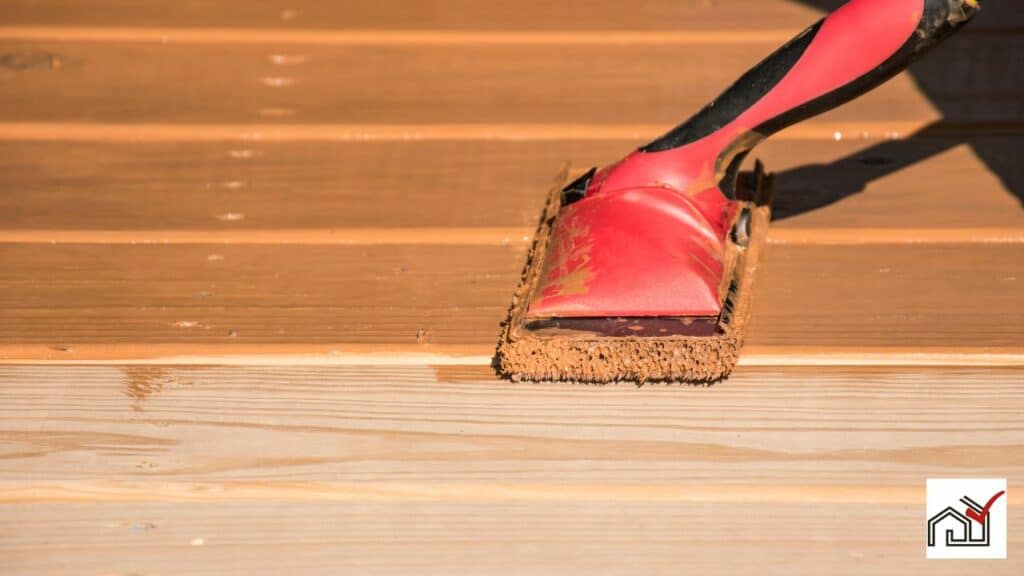Regular staining is key to preserving both the appearance and durability of a deck. The recommended frequency for re-staining is typically every 2 to 3 years, but this can vary based on the type of wood, the quality of the previous stain job, and the climate.
To determine if your deck needs staining, look for signs of wear such as color fading, graying of the wood, or if the wood absorbs water. Regular maintenance, including timely staining, is crucial for the deck's longevity and aesthetic appeal.
Assessing Your Deck's Condition
Assessing the condition of your deck is crucial for determining if it needs re-staining. Homeowners should generally stain their decks every two to three years, but this may vary based on the climate, usage, and exposure to the elements. Signs that your deck requires staining include fading stain color and noticeable color differences.
To maintain your deck properly, inspect it for mold and mildew, which can damage the wood. Use the Water Test to check if re-staining is needed: sprinkle water on the deck, and if it absorbs instead of beading, the deck needs a new coat of stain.
Perform the Visual Inspection Test quarterly to look for lighter areas or uneven coloration, indicating that maintenance may be necessary.
Understanding Stain Durability
To maintain a deck properly, it's important to know how long the stain will last. A good stain typically protects wood for 3 to 5 years. The stain's ability to endure weather conditions like sunlight and rainfall is essential. Cleaning and prepping the deck before staining is critical for the stain to stick and provide protection.
The need to restain a deck varies based on the wood type, exposure to weather, and the quality of the previous stain. These factors affect the lifespan of the stain. The drying time of the stain also impacts its durability; a fully cured stain is more resistant to damage.
To determine if a deck needs restaining, look for dry or aged wood, mold, splintering, and color fading. When these signs are present, it's time to inspect the deck and schedule maintenance. Regular care preserves the deck's strength and appearance, highlighting the importance of understanding stain durability for effective deck upkeep.
Best Seasons for Deck Staining
The best time to stain a deck is from late spring to early fall when temperatures are moderate and humidity is lower. This weather is ideal for outdoor work. Avoid staining in extreme summer heat or winter cold, as these conditions can affect stain quality and durability.
Optimal staining temperatures are between 50-90°F, typically found during late spring and early fall. These conditions allow the stain to dry properly. The deck should remain dry for at least 48 hours post-application for proper stain setting.
Decks need refinishing every few years to maintain their look and protect the wood. The lifespan of a stain depends on the product type, weather exposure, and application quality. Oil-based stains generally last longer than water-based ones and may not need refinishing as often.
It's recommended to refinish a deck every two to three years, depending on its condition. Staining in the right season ensures an efficient process and a durable finish, enhancing the appearance and longevity of your deck.
Preparing Your Deck for Staining
Before staining your deck, ensure it is clean, dry, and free of old finishes. Proper preparation prevents peeling and wear. Allow new wood to weather for 30 days to six months, depending on whether it is pressure-treated or kiln-dried.
Clean the deck to remove mold, mildew, or old stain, using a power washer with appropriate pressure to avoid damage. After cleaning, let the deck dry completely, as moisture affects stain absorption. This may take several days in humid conditions.
Inspect and repair any deck damage. Once dry, apply the stain evenly to penetrate the wood and provide protection and appearance enhancement.
Staining New Vs. Older Decks
The age of your deck is important when deciding on a staining schedule. New decks need time to dry before applying stain, with green lumber requiring anywhere from 30 days to six months, while kiln-dried lumber generally needs one to two months.
Older decks may need re-staining once signs of wear show or water stops beading on the surface, typically every two to three years, though harsh weather can necessitate more frequent maintenance.
Stain application requires several hours to dry, with exact times varying due to temperature and humidity. Stain your deck in late spring or early fall at temperatures between 50-90°F for optimal results.
Proper maintenance and timely staining will help maintain your deck's durability and appearance.
Maintenance Between Stainings
Routine maintenance can extend the time between deck stainings. Typically, a deck should be stained every two to three years, but regular upkeep is key to achieving this. Checking the deck every six months for uneven color or patches helps identify areas needing care to prevent complete re-staining.
Weather and exposure determine the re-staining schedule; decks in harsh conditions may need more frequent attention. Contrary to some beliefs, stained decks require ongoing maintenance. Annual cleaning and possibly a maintenance coat of stain can be necessary.
Drying times for stains vary, but consistent maintenance is crucial for the wood's longevity and appearance. Regular care reduces the need for full re-staining and keeps the deck looking good.
Choosing a Professional Stainer
Choosing a professional stainer is essential for achieving a high-quality finish and protection for your deck. Hire experts from independently owned and operated businesses for a personalized service. Research local services by entering your ZIP/Postal code on company websites and look for those offering free, detailed estimates of the cost to stain your deck.
A good stainer will fit the project into your schedule and handle additional tasks like pressure washing and carpentry to prepare your deck for staining, ensuring longevity and aesthetic appeal. Verify the stainer's credentials and read customer reviews to make an informed choice.
A well-selected professional will deliver a durable and attractive finish to your deck.





